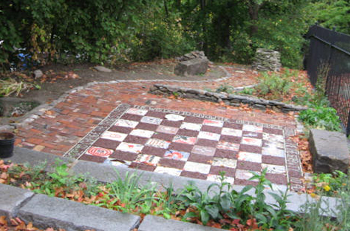Located between South Boston High School and Dorchester Heights, this space is open to the public year-round.
We just commemorated 25 Years at No Man’s Land with an anniversary event, unveiling our newest public art project, The 12 Steps of Recovery. Thank you to everyone that celebrated with us!
Mosaic of the 1st of 12 Steps of Recovery, reading “We admitted we were powerless over substances—that our lives had become unmanageable.”
South Boston is one of the oldest and most historical communities in the United States. It has traditionally been known as the “Irish Catholic” neighborhood of Boston. Its rich history is chock-full of moments that have shaped the community’s sense of self, including feelings of displacement and marginalization. A few key historical moments that specifically shape the No Man’s Land project, include:
- 1970s—South Boston residents protested against Boston’s citywide effort to desegregate the public school system (on the steps of South Boston High School). Community members felt like one of their key neighborhood institutions was being torn away from them, causing fear and uncertainty of the “other”. This played out as long-lasting racial tension in the community.
- Mid-1990s: A wave of teen suicides and drug overdoses seized the South Boston community. “In the first 8 months of 1997, 70 teen-agers, most of them male, were hospitalized for attempting or considering suicide.”[1]
Starting in 1996, No Man’s Land was renovated and revitalized in response to the community’s need to be re-introduced to South Boston High School—a school that felt lost to the community after the whole citywide busing initiative. The space had become a blighted piece of land, well known for being rampant with substance abuse and other violent activity. Artistic Director, Michael Dowling, felt it was important to address the deeply rooted pain and marginalization the South Boston community was feeling, which was manifesting itself in multiple ways (including the mistreatment and lack of care residents had for the No Man’s Land space). He organized a community day at No Man’s Land in conjunction with The Revolving Museum, inviting community members to tell their stories and participate in building a beautiful stone spiral. This day marked the beginning of our initiative at No Man’s Land to invite the community to reclaim the space and drive community-wide healing.
In 1998, the project evolved into something much bigger after the wave of suicides and drug overdoses hit the community. A group of teens funded through YO Boston and led by Leo Rull, joined forces with Dowling, seeking solace and an opportunity to channel their grief and anger into a project after having lost so many friends. Under his mentorship, they created a Celtic Cross Memorial on the slope of No Man’s Land, which was recently featured during a community-wide prayer vigil. This founding group of young people played a pivotal role in the initial landscaping and transformation of No Man’s Land, as well as the formation of our efforts to engage young people in our public art projects.
Over the last 21 years, No Man’s Land has continued to be renovated and restored to its natural glory. Design elements such as a portal, path, and sense of surround have been incorporated into the space, in addition to public benches and an outdoor classroom. The project made such an impression on Boston city officials that the city decided to officially make Medicine Wheel Productions stewards of the city owned land.
Youth are an integral part of MWP’s ongoing public art projects, including the work that happens at No Man’s Land. Fifty young men and women, ages 14-25, work at No Man’s Land throughout the year, helping with a number of projects such as the Poetry Path, First Bloom Project, Serenity Garden, Labyrinth, and many others. Many of these young people come to Medicine Wheel bearing serious burdens in life—more than half of our participants are court involvement and around the same number have struggled with substance abuse issues. Their work at No Man’s Land provides them with an outlet to heal and reclaim their lives, while also gaining tangible skills in landscaping and public art.
[1] Staples, Brent. A Prayer for the Dead, 1999. The New York Times: http://www.nytimes.com/books/99/10/03/reviews/991003.03staplet.html




